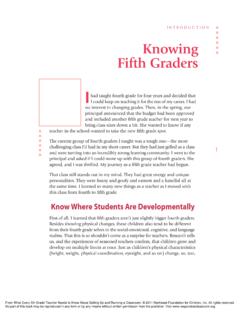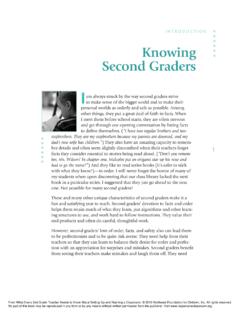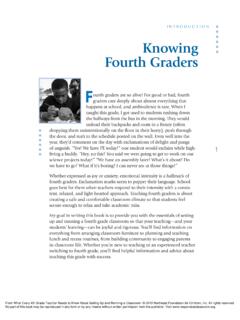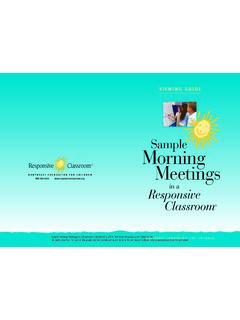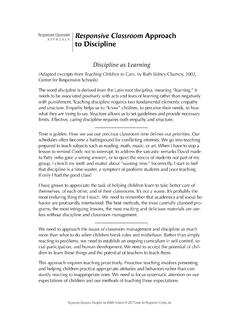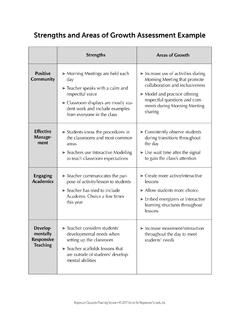Transcription of INTRODUCTION Knowing Fifth Graders - …
1 Taught fourth grade for four years and decided thatI could keep on teaching it for the rest of my career. I hadno interest in changing grades. Then, in the spring, ourprincipal announced that the budget had been approvedand included another Fifth grade teacher for next year tobring class sizes down a bit. She wanted to know if anyteacher in the school wanted to take the new Fifth grade current group of fourth Graders I taught was a tough one the mostchallenging class I d had in my short career. But they had just gelled as a classand were turning into an incredibly strong learning community. I went to theprincipal and asked if I could move up with this group of fourth Graders . Sheagreed, and I was thrilled. My journey as a Fifth grade teacher had begun. That class still stands out in my mind. They had great energy and uniquepersonalities. They were funny and goofy and earnest and a handful all atthe same time. I learned so many new things as a teacher as I moved withthis class from fourth to Fifth Where Students Are developmentallyFirst of all, I learned that Fifth Graders aren t just slightly bigger fourth showing physical changes, these children also tend to be differentfrom their fourth grade selves in the social-emotional, cognitive, and languagerealms.
2 That this is so shouldn t come as a surprise for teachers. Research tellsus, and the experiences of seasoned teachers confirm, that children grow anddevelop on multiple fronts at once. Just as children s physical characteristics(height, weight, physical coordination, eyesight, and so on) change, so, too,I N T R O D U C T I O NKnowingFifth Graders From What Every 5th Grade Teacher Needs to Know About Setting Up and Running a Classroom. 2011 Northeast Foundation for Children, Inc. All rights reserved. No part of this book may be reproduced in any form or by any means without written permission from the publisher. Visit do other characteristics, such as attention span, friendship preferences, abil-ity to think abstractly, and sense of humor. When we understand the com-mon characteristics of Fifth Graders , we can create classroom spaces, designlessons, and group children in ways that are especially appropriate for Characteristics of Fifth GradersI sometimes joke that as an extrovert, I often need to talk to think.
3 Many fifthgraders seem to share that need. Whether working on math problems, walk-ing in the hallways, conducting a science experiment, riding on the schoolbus, or waiting for an assembly to begin, Fifth Graders generally love to course, we could say this of just about any age (and for adults as well aschildren), but in Fifth grade, this characteristic seems especially prominent. This need to talk constantly can be a real challenge if one of our goals is tohave a quiet classroom and school environment. And while the importanceof a quiet school environment is often overemphasized, I think that mosteducators would agree that a generally calm and quiet classroom helps chil-dren to concentrate and feel safe. So what might school look like if we lever-aged the super-chattiness of Fifth Graders in ways that could help with theirlearning? Here s what I do: I group students together at desks and tables in small collab-orative clusters, spaced apart from one another.
4 I use interactive modeling(discussed in detail in Chapter 2) to teach Fifth Graders how to use quietvoices while talking in the hallways and then let them walk in pairs insteadof in single file. And I incorporate partner-chats, peer conferences, and othercollaborative structuresinto daily lessons in allsubjects. Rather thanspend time and energytrying to keep Fifth gradersquiet, I teach them howand when to talk produc-tively. If you think of fifthgraders common charac-2 Rather than spend time and energy trying to keep Fifth Graders quiet, I teach them howand when to talk productively. If you thinkof Fifth Graders common characteristics asassets, not liabilities, you can use them tohelp students capitalize on their From What Every 5th Grade Teacher Needs to Know About Setting Up and Running a Classroom. 2011 Northeast Foundation for Children, Inc. All rights reserved. No part of this book may be reproduced in any form or by any means without written permission from the publisher.
5 Visit teristics as assets, not liabilities, you can use them to help students capital-ize on their inclination to talk is just one char-acteristic that many Fifth Graders general, they also can take on morecomplex work in school, are becomingmore focused on peer relationships,and can think more abstractly. The table on pages 4 6 highlights some of the most common characteristicsof Fifth Graders . As you explore this table, it s important to keep these ideasin mind:nHuman development is scientists who study it do notfully agree on the means by which humans grow socially, emotionally,linguistically, or cognitively. Most theorists describe the process as a dy-namic interaction between a person s biological disposition and many environmental factors including the historical era in which a persongrows up, the person s culture and family, and the institutions he or sheencounters (such as schools, places of worship, and the media).
6 The tableis not intended to ignore this complexity. Instead, it offers you a bridgebetween the abstract ideas of theory and their practical expression in chil-dren s classroom child is unique. As a result of the complex and dynamic process of development, no two children not even identical twins with the samegenetic makeup will develop in the same way or at the same rate. And formany children, one area may develop at a much faster rate than example, a particular Fifth grader might have social-emotional behav-iors that are very common among fourth Graders (such as preferring to playor work with one or two friends and being less concerned with popular trends or social status). But that child may also have cognitive behaviorsmore like those of a sixth grader (such as more advanced math or readingskills). Finally, it s important to keep in mind that the traits listed in thetable should never limit your thinking about a student s potential.
7 Therewill always be individuals with capabilities beyond those considered typi-cal; not every child will fit neatly into the categories outlined here. 3 From What Every 5th Grade Teacher Needs to Know About Setting Up and Running a Classroom. 2011 Northeast Foundation for Children, Inc. All rights reserved. No part of this book may be reproduced in any form or by any means without written permission from the publisher. Visit nThe table gives you a practical frame of lets you prepare forteaching Fifth Graders and gives you a resource if something puzzlingcomes up. For instance, once you start teaching Fifth grade, you may notice that some students keep complaining about being hungry in themiddle of the morning, even though they ate breakfast and have the earli-est lunch. Once you know that many Fifth Graders are experiencing growthspurts and struggling to maintain their energy levels, you might adjust tothis developmental need by introducing a snack option that allows themto eat while they work (within certain guidelines you set).
8 Instead ofgetting frustrated with this or any other behavior, use your knowledge of Fifth Graders common characteristics to develop practical solutionsthat support their healthy growth and learn more about child development, see the resources in the AboutChild Development section on page Generally happy; enjoy family, peers, Work well in Usually truthful; developing a more mature sense of right and Sensitive to and able to resolve issues able to enjoy cooperative and competi-tive Build group work into lessons, activities,and projects. (Flexible groups can workwell; students can work with lots of differ-ent people, including adults and peers.)n Expect arguments (and that they will tendto end quickly).n Encourage their developing sense of fair-ness and of right and wrong. (these canlead to lively class debates and discussions.)n Provide opportunities for peer tutoring,book buddies, and development of conflictresolution and other interpersonal GradersCommon CharacteristicsSchool implicationsSocial-Emotional From What Every 5th Grade Teacher Needs to Know About Setting Up and Running a Classroom.
9 2011 Northeast Foundation for Children, Inc. All rights reserved. No part of this book may be reproduced in any form or by any means without written permission from the publisher. Visit n Large muscles developing Drawn to the outdoors and physical handwriting may become messier than in fourth Due to growth spurts, frequently hungryand can tire Set up schedules to include sufficient timefor recess (and other outdoor play), ener-gizers and other movement breaks, snacks,and Consider a snack option that enables stu-dents to eat and work in the Provide instruction and practice for use of tools such as rulers, compasses, GradersCommon CharacteristicsSchool implicationsPhysical5sCONTINUEDC ognitiven Good at memorizing Increasingly able to think abstractly; goodat solving Enjoy rules and Enjoy collecting, classifying, and take pride in able to concentrate for longer periods Structure complex projects with properscaffolding and guidance to build on theirabilities to be highly productive Give ongoing encouragement and rein-forcement for both effort and Include lessons that help build theirmemory skills (for example, practicingmath facts and learning facts about geog-raphy, history, and world records).
10 N Support classification and other organiza-tional skills with hands-on science workand math projects. From What Every 5th Grade Teacher Needs to Know About Setting Up and Running a Classroom. 2011 Northeast Foundation for Children, Inc. All rights reserved. No part of this book may be reproduced in any form or by any means without written permission from the publisher. Visit Fifth Graders CONTINUEDC ommon CharacteristicsSchool implicationsLanguage6the information in this chart is based on Yardsticks: Children in the Classroom Ages 4 14,3rd ed., by Chip Wood (Northeast Foundation for Children, 2007), and is consistent with the following sources:Child Development Guideby the Center for Development of humanServices, SUNY, Buffalo State College. W W. B S C - C D h S . o r G / F o S t E r Pa r E N t t r a I N I N G / P D F S / C h I L D D E v E L G U I D E . P D F the Child in the Elementary School by Frederick C. howe in Child StudyJournal,vol.


